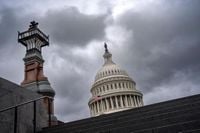Federal workers across the United States are reeling after the Trump administration initiated sweeping layoffs during the ongoing government shutdown, with the Internal Revenue Service (IRS) and several other key agencies among the hardest hit. The sudden wave of reduction-in-force (RIF) notices—delivered on Friday, October 10, 2025—has sparked widespread shock, legal challenges, and growing concerns about the federal government’s capacity to deliver essential services as tax season looms and critical programs grind to a halt.
According to Federal News Network, the Treasury Department laid off approximately 1,446 employees, most of whom worked for the IRS in human resources and IT. This move is part of a broader reduction that targeted more than 3,500 federal workers across seven agencies, as reported by CNN. The layoffs come at a precarious moment for the IRS, which has already lost over a quarter of its workforce this year due to voluntary separation incentives, early retirements, and deferred resignation programs. Many employees had been told just months earlier that layoffs were “off the table,” only to be blindsided by the pink slips.
“We had received an email—great news, RIFs are off the table for the foreseeable future. We lost too many people through DRP and attrition,” one IRS human resources employee told Federal News Network on condition of anonymity. But that sense of relief was short-lived. The IRS had planned to invite 700 revenue agents and officers to return after accepting deferred resignation, but this plan was scrapped in favor of hiring new staff from the public. “The plan going forward then was, ‘We’ll just put out these hiring announcements. DRP people, they’re welcome to apply if they’d like, but this is just open to the public. It’s open to everybody,’” the employee explained.
The cost of onboarding a new IRS contact service representative is steep—about $15,000 per hire, including background checks and training, which can take up to a year. The agency now faces the daunting task of hiring and training roughly 3,500 new employees just to maintain current levels of phone support. And with the next tax filing season already on the horizon, time is not on their side. “Even if they bring on these 3,500 contact reps that they had the announcement for, they’re not going to be fully trained in time,” the HR employee warned.
The layoffs have reached into vital corners of the IRS, including the dedicated hotline for tax professionals and an entire team that investigates under-reported income. The resulting furloughs threaten to create major backlogs and further undermine taxpayer services once the shutdown ends. “There are more people leaving federal service now than I have ever seen, because they’ve been bullied into leaving,” said a union official, echoing the frustration and uncertainty felt by many.
Technology staff have not been spared either. Several IRS IT employees with outstanding performance reviews received layoff notices, raising alarms about the agency’s ability to keep its already outdated systems running smoothly. “Our systems are already outdated and lagging, and it’s going to be detrimental,” another employee told Federal News Network. “It will be a huge impact.”
Douglas Jackson, a service-disabled Marine Corps veteran who was laid off from his IRS public affairs job, voiced his disbelief to CNN after hearing Vice President JD Vance frame the layoffs as a choice between “Americans and federal bureaucrats.” “I’m an Orlando veteran. I’m not a DC bureaucrat,” Jackson said. He questioned the administration’s assertion that laid-off workers were predominantly “Democrat-oriented,” pointing out, “There’s no way he could know our party affiliation.” Jackson, who has voted for both parties, said the layoffs felt like a betrayal of the administration’s pledge to protect veterans, describing the situation as “retaliatory” and “retribution.”
The Trump administration has been candid about its intentions. President Trump told reporters that the shutdown was being used as an opportunity to close federal programs “that we wanted to close up, or that we never wanted to happen.” He added, “We are closing up Democrat programs that we disagree with, and they’re never going to open again.” The Office of Management and Budget (OMB) reinforced this message on social media, stating, “Pay the troops, pay law enforcement, continue the RIFs, and wait.”
Vice President Vance, speaking on NBC’s “Meet the Press,” insisted that the layoffs were necessary to preserve critical federal assistance programs, such as the WIC nutrition program and military pay, blaming Democrats for the reductions. “We have to lay off some federal workers in the midst of this shutdown to preserve the essential benefits for the American people that the government does provide,” Vance said. However, budget experts disputed this rationale. As Bobby Kogan of the Center for American Progress explained to CNN, most federal workers aren’t being paid during the shutdown, so layoffs would not free up immediate funds. Michael Linden, a senior policy fellow at the Washington Center for Equitable Growth, added that any savings from the layoffs would be “only a tiny fraction” of what’s needed for WIC and military budgets.
The layoffs extend well beyond the IRS. The Treasury Department’s Community Development Financial Institutions Fund, which supports economic revitalization in low-income areas, was gutted. The Department of Energy lost staff from offices overseeing energy efficiency, clean energy, and minority economic impact. The Department of Housing and Urban Development’s Office of Community Planning and Development, which manages grants for low-income housing and homelessness, also faced cuts. At the Department of Homeland Security, the Cybersecurity and Infrastructure Security Agency—charged with defending against cyberattacks—was affected. The Environmental Protection Agency’s Office of Land and Emergency Management, responsible for hazardous waste cleanup, saw layoffs as well. The Department of Education’s Office of Special Education and Rehabilitative Services, which supports millions of children and adults with disabilities, was not spared either. Even the Centers for Disease Control and Prevention (CDC) laid off about 600 workers, including staff in violence prevention and injury control programs.
Unions representing federal workers have responded by filing a lawsuit in California federal court, calling the layoffs illegal and urging a judge to halt the RIFs. The legal battle is ongoing, with District Court Judge Susan Illston yet to rule on the request for a temporary restraining order.
As the shutdown drags on and more layoffs loom, federal employees and their advocates warn of lasting damage—not just to government operations, but to the trust and morale of the public servants who keep the country running. For many, the uncertainty and upheaval are taking a heavy toll, and the question of how—and whether—the government can recover from this crisis remains painfully open.


